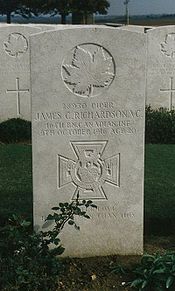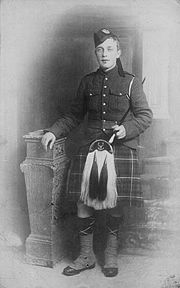
James Cleland Richardson
Encyclopedia

Victoria Cross
The Victoria Cross is the highest military decoration awarded for valour "in the face of the enemy" to members of the armed forces of various Commonwealth countries, and previous British Empire territories....
(25 November 1895, Bellshill
Bellshill
Bellshill is a town in North Lanarkshire, Scotland, 10 miles south east of Glasgow city centre and 37 miles west of Edinburgh. Other nearby towns are Motherwell , Hamilton and Coatbridge . Since 1996, it has been situated in the Greater Glasgow metropolitan area...
, Scotland
Scotland
Scotland is a country that is part of the United Kingdom. Occupying the northern third of the island of Great Britain, it shares a border with England to the south and is bounded by the North Sea to the east, the Atlantic Ocean to the north and west, and the North Channel and Irish Sea to the...
– 8 or 9 October 1916) was a Canadian
Canada
Canada is a North American country consisting of ten provinces and three territories. Located in the northern part of the continent, it extends from the Atlantic Ocean in the east to the Pacific Ocean in the west, and northward into the Arctic Ocean...
recipient of the Victoria Cross
Victoria Cross
The Victoria Cross is the highest military decoration awarded for valour "in the face of the enemy" to members of the armed forces of various Commonwealth countries, and previous British Empire territories....
, the highest and most prestigious award for gallantry in the face of the enemy that can be awarded to British
United Kingdom
The United Kingdom of Great Britain and Northern IrelandIn the United Kingdom and Dependencies, other languages have been officially recognised as legitimate autochthonous languages under the European Charter for Regional or Minority Languages...
and Commonwealth
Commonwealth of Nations
The Commonwealth of Nations, normally referred to as the Commonwealth and formerly known as the British Commonwealth, is an intergovernmental organisation of fifty-four independent member states...
forces.
He was 20 years old, born in Scotland and a resident of Vancouver, British Columbia, Canada and then Chilliwack, BC. He was a Piper
Bagpipes
Bagpipes are a class of musical instrument, aerophones, using enclosed reeds fed from a constant reservoir of air in the form of a bag. Though the Scottish Great Highland Bagpipe and Irish uilleann pipes have the greatest international visibility, bagpipes of many different types come from...
in the 72nd Seaforth Highlanders of Canada (he is shown wearing a Seaforth uniform below) and he proceeded overseas as part of the large Seaforth contingent of the 16th (Canadian Scottish) Battalion, Canadian Expeditionary Force
Canadian Expeditionary Force
The Canadian Expeditionary Force was the designation of the field force created by Canada for service overseas in the First World War. Units of the C.E.F. were divided into field formation in France, where they were organized first into separate divisions and later joined together into a single...
, during the First World War when the following deed took place for which he was awarded the VC.
During the Battle of the Ancre Heights
Battle of the Ancre Heights
The Battle of the Ancre Heights was a prolonged battle of attrition in October 1916 during the Battle of the Somme. Lieutenant General Hubert Gough's Reserve Army had finally managed to break out of the positions it had occupied since the start of the Somme fighting and Gough intended to maintain...
on October 8th 1916 at Regina Trench, Somme
Somme
Somme is a department of France, located in the north of the country and named after the Somme river. It is part of the Picardy region of France....
, France
France
The French Republic , The French Republic , The French Republic , (commonly known as France , is a unitary semi-presidential republic in Western Europe with several overseas territories and islands located on other continents and in the Indian, Pacific, and Atlantic oceans. Metropolitan France...
, the company was held up by very strong wire and came under intense fire. Piper Richardson, who had obtained permission to play the company 'over the top' strode up and down outside the wire playing his pipes, which so inspired the company that the wire was rushed and the position captured. Later the piper was detailed to take back a wounded comrade and some prisoners, but after proceeding some distance he insisted on turning back to recover his pipes which he had left behind. He was never seen again.
He is also considered Scottish. Grave/memorial at Buried at Adanac Military Cemetery
Adanac Military Cemetery
Adanac Military Cemetery is a Commonwealth War Graves Commission burial ground for the dead of World War I located near the French villages of Miraumont, Pys and Courcelette. The cemetery was formed after the war ended from the consolidation of existing burial sites, primarily the graves from the...
, France. 6m NE of Albert. Plot III. Row F. Grave 36. Headstone.

Richardson's Bagpipes
Richardson's bagpipes were believed to have been lost in the mud of the Somme for almost 90 years until 2002, when the Pipe Major of The Canadian Scottish Regiment (Princess Mary's)The Canadian Scottish Regiment (Princess Mary's)
The Canadian Scottish Regiment is a Primary Reserve infantry regiment of the Canadian Forces based on Vancouver Island British Columbia.The regiment is located in Victoria, Nanaimo, and Courtenay, British Columbia...
responded to an Internet posting. He discovered that Ardvreck preparatory school in Scotland had possession of a set of bagpipes with the unique Lennox tartan on them, the same tartan used by the pipers of the 16th (Canadian Scottish) Battalion. A British Army Chaplain, Major Edward Yeld Bate, had found the pipes in 1917 and brought them back home after the war to a school in Scotland where he was a teacher. The pipes were unidentified for several decades, and served as a broken, mud-caked, and blood-stained reminder of an unknown piper from the Great War.
Andrew Winstanley of The Canadian Club and Pipe Major Roger McGuire were largely responsible for the investigative work into identifying Richardson's pipes. With the support of The Canadian Club and a group of patriotic citizens, Pipe Major McGuire travelled to Scotland in January 2003 to help identify the pipes that had been displayed at Ardvreck School in Crieff, Perthshire, Scotland, for over seven decades. Tomas Christie, a parent of students there and also a piper, initiated the search for the origin of the pipes.
Their collective effort led to conclusive evidence that identified the pipes as those played by Piper Richardson on that fateful day in 1916. An anonymous donor facilitated the purchase of the pipes on behalf of the citizens of Canada. In October 2006, a party of dignitaries visited Scotland and received the pipes from the Headmaster of Ardvreck School for repatriation to Canada.
On 8 November, 2006, the bagpipes were officially repatriated when troops from The Canadian Scottish Regiment (Princess Mary's)
The Canadian Scottish Regiment (Princess Mary's)
The Canadian Scottish Regiment is a Primary Reserve infantry regiment of the Canadian Forces based on Vancouver Island British Columbia.The regiment is located in Victoria, Nanaimo, and Courtenay, British Columbia...
placed them at the British Columbia Legislature as a reminder of a generation's valour. They are currently on public display.
External links
- The Canadian Scottish Regiment (Princess Mary's) Warrant Officers' and Sergeants' Mess (Piper James Cleland Richardson entry)
- Biography at the Dictionary of Canadian Biography Online
- JAMES CLELLAND RICHARDSON (service/personal details, photograph, citation, relevant documents, burial information)
- Piper Richardson Statue (Master Sculptor John Weaver was commissioned to create a life size bronze sculpture of Piper Richardson in Chilliwack, BC, Canada)
- Legion Magazine article on James Richardson
- Find-A-Grave profile for James Cleland Richardson
- Army News Story - Repatriation of Richardson's Pipes
- Richardson's Medals at the Canadian War Museum

